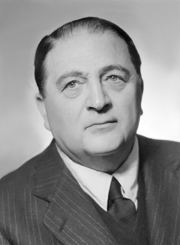Name Raffaele Guariglia | ||
 | ||
Un ricordo di Raffaele Guariglia
Raffaele Guariglia, Barone di Vituso (Naples, 19 February 1889 – Rome, 25 April 1970) was an Italian diplomat. He is best known for his brief service as Minister of Foreign Affairs in the short-lived 1943 World War II-era Italian government headed by Pietro Badoglio.
Contents
Ambassador
Born in 1889 as heir to the noble Neapolitan family of di Vituso, Guariglia had the connections necessary to make a career in the Italian Foreign Service, which he joined in 1909. During his first twenty-three years in the service, he occupied a series of diplomatic posts of sub-ambassadorial rank, serving in Paris, London, St. Petersburg, Brussels, and other capitals. Meanwhile the Italian government fell under the domination of Benito Mussolini.
Guariglia attained ambassadorial rank in 1932 when he was named Italy's ambassador to Spain. In 1935 he was translated to Buenos Aires and in 1937 to France. In Paris, he achieved close friendship with a person with insider status in the French government, the Countess Hélène de Portes. De Portes had separated from her noble husband and developed a tie as the long-term romantic partner of a rising French politician, Paul Reynaud. In 1938 Reynaud became Minister of Finance. Although Reynaud's own position was that of staunch opposition to Nazi Germany, his partner's growing liaison with Italy, together with Italy's deepening ties to Germany, compromised this opposition. Guariglia's work was complicit in this power shift.
In May–June 1940 de Portes and Reynaud, who had become Prime Minister of France, were leading their country as it fell under blitzkrieg attack. When Italy declared war on a defeated France on 10 June 1940, Guariglia's services as ambassador were no longer appropriate.
Foreign Minister
Guariglia was serving as Italy's ambassador to neutral Turkey in 1943 when Mussolini's government fell. As an Italian patriot who had loyally served the Fascist regime without developing close personal ties to Mussolini, the career diplomat was Badoglio's choice to be the Foreign Minister of what Rome hoped would be a successful neutralist government. Guariglia returned to the Ministry, took on his new responsibilities on 30 July 1943, and almost at once opened indirect negotiations with the Western Allies.
Nazi Germany was not interested in a neutral Italy, and its army actually possessed physical control over most of the peninsula. Furthermore, Guariglia soon found that the Allies were demanding the unconditional surrender of Italy. The result of these counter-pressures was such that six days after the hapless foreign minister and his Cabinet colleagues oversaw the signing of an armistice with the Allies on 3 September, the German army physically occupied the peninsula and carried on the war. On 9 September, the Badoglio government disintegrated. The prime minister and many of the members of his government fled to Allied-occupied Brindisi; Guariglia and other members of the government attempted to remain in Rome, but soon found they were not safe and had no power in a capital city under German occupation. The foreign minister, who had earlier served as ambassador to Spain, found himself taking refuge in the Spanish Embassy in Rome, under the protection of the Francisco Franco government. Guariglia had by now ceased to serve as Foreign Minister de facto, but remained in this post de jure until dismissed on a long-distance basis by the fugitive Badoglio on 11 February 1944.
Later life
Guariglia, an Italian baron and supporter of the House of Savoy, was not eligible to serve in cabinet after the abdication of Umberto II in 1946. He did not lose hope for the restoration of the monarchy, and served as national president of the Italian Monarchist Union and as a monarchist member of the Italian Senate. Age 81, he died in Rome in 1970.
